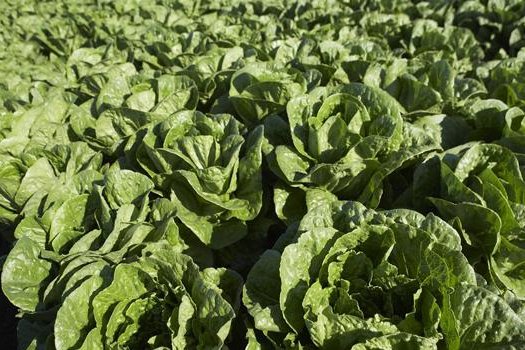Hundreds have become sick eating E. coli-contaminated romaine lettuce over the last two years, but neither farmers nor the federal investigators know what is causing the contamination. Photo courtesy of the California Leafy Green Marketing Agreement
EVANSVILLE, Ind., Nov. 28 (UPI) -- Growers are becoming desperate to determine that cause of contamination after federal investigators traced yet another E. coli outbreak to romaine lettuce last week.
Despite multiple investigations and various efforts to increase safety procedures, industry leaders say they are no closer learning how bacteria infested the vegetable.
"That is the question we look at each other every day and ask," said Dan Sutton, a romaine grower in Salinas, Calif., the apparent origin of the latest outbreak. "Why? Why did this happen? Why does it keep happening? We do everything we can every day to not have this happen. What do we need to do differently?"
Since early 2018, more than 350 people have become sick, and five have died, in four separate E. coli outbreaks linked to romaine lettuce. As of Tuesday, the Centers for Disease Control and Prevention confirmed that 67 people in 19 states were made sick, 39 of whom were hospitalized. No one has died.
Each outbreak originated in distinct regions of California and Arizona, where the majority of America's romaine is grown.
In all cases, the contaminated lettuce might have come from several farms in the growing region, the CDC said. That indicates something widespread in the environment could be causing the contamination, said Jennifer McEntire, vice president of food safety and technology for the United Fresh Produce Association in Washington, D.C.
But no one is sure exactly what.
"We don't have any grand answers as to why we've had this string of issues over the last two years," said Scott Horsfall, chief executive officer of California Leafy Green Products Handler Marketing Agreement, an industry group that sets food safety requirements for its members.
Federal investigators are looking for those answers, he added. The Food and Drug Administration this month began widespread romaine testing in hopes of zeroing in on the source of the E. coli.
Meanwhile, farmers are trying to cut off any possible source for contamination.
"E. coli is something that is in the environment," Horsfall said.
It's a bacteria found in the intestines of animals -- including humans. It also can be found in water and soil. Because of this, lettuce growing in an open field could become contaminated in several ways. They include an agricultural worker with unwashed hands, deer walking through the field, a herd of cows upstream or contaminated irrigation water.
The FDA has said that several of the previous outbreaks might have come from contaminated water that either was used to irrigate romaine fields or somehow flooded them.
California growers responded in April by increasing water testing. Members of the California Leafy Green Products Handler Marketing Agreement group -- which comprises roughly 90 percent of all the leafy greens grown in the United States, according to its website -- are now required to test all irrigation water before using it.
"We've also banned the use of surface water for overhead irrigation unless it is treated in the last 21 days before harvest," Horsfall said. Overhead irrigation is a system by which water is pressurized and then pumped up into units that spray across fields.
But as outbreaks continue despite these efforts, consumers' willingness to buy romaine appears to be diminishing.
This is the second consecutive year an outbreak has hit days before Thanksgiving. Last year's outbreak sickened 210 and killed 5.
At that time, the FDA did not know where the contaminated lettuce came from, so it issued a blanket advisory warning consumers not to eat any romaine.
Stores pulled lettuce from shelves and restaurants removed salads from menus. Warehouses stocked full of greens bound for Thanksgiving dinner tables suddenly were cleaned out.
During this year's Thanksgiving outbreak, the FDA had determined the region from which the contaminated lettuce came, and its advisory only applied to lettuce from that area.
"Most retailers are pulling all romaine and all the things that look like romaine, anyway," said Michael Droke, an attorney at the law firm Dorsey & Whitney LLP who works with retailers to handle food recalls.
"Consumer demand has dropped significantly." Droke said. "When you have a high-profile recall like this, consumers stop buying it. They serve something else for Thanksgiving."
Industry groups do not have firm figures on how much money growers, packers and retailers have lost because of the outbreaks and the subsequent drop in demand.
Researchers at the University of California-Davis Department of Agricultural and Resource Economics have launched a study to determine the economic impact of last year's outbreak. Preliminary results of that study should be available by spring.
"The romaine market is suffering," said grower Sutton, who also is chairman for the California Leafy Green Handler Marketing Agreement.
Farmers who grow romaine outside of California are working hard to convince customers that their lettuce is safe. Florida Agriculture Commissioner Nikki Fried, for example, urged consumers this week to seek out romaine lettuce with a "Fresh from Florida" logo.
"Our demand has actually gone up," said Tracy Nazzaro, the president and general manager of Traders Hill Farm in Hilliard, Fla., which grows romaine indoors using aquaponics.
Because its lettuce is grown indoors in a controlled environment, there are far fewer ways for it to become contaminated with E. coli, Nazzaro said.
Traders Hill sells romaine mostly to restaurant chefs.
"I have a relationship with those chefs," Nazzaro said. "They're able to share with their customers where the romaine came from, because customers do ask. People are getting more savvy about this.
"As a consumer myself, I'd probably avoid all California romaine products, just to be safe," she said. "This is becoming tricky for anyone shipping out of California."















